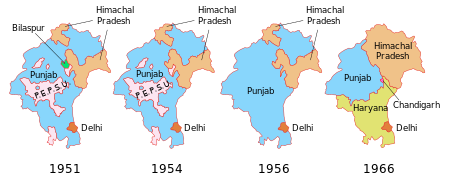Punjab and Haryana High Court
The Punjab and Haryana High Court ( Panjabi ਪੰਜਾਬ ਅਤੇ ਹਰਿਆਣਾ ਹਾਈਕੋਰਟ , Hindi पंजाब और हरियाणा उच्च न्यायालय ) is a high court in India based in the city of Chandigarh . Its jurisdiction extends to the states of Punjab and Haryana , as well as the union territory of Chandigarh.
history
On February 16, 1866, the Chief Court of the Punjab was set up in what was then the British-Indian province of Punjab . The division courts, district courts, and other courts at local levels were subordinate to the court. With effect from March 20, 1919, George V raised the Chief Court to a fully valid High Court for the province of Punjab and Delhi by means of a letters patent . The legal basis for the royal - imperial patent was the Government of India Act, 1915 , which in section 113 authorized the monarch to set up such higher courts. The High Court took its seat in Lahore , the provincial capital, and was named High Court of Judicature at Lahore . When it was established, the High Court had a presiding judge ( Chief Justice ) and six other judges. From 1920 to 1943 (when the United Kingdom renounced special rights for its nationals in China) the High Court also had consular jurisdiction over the British Consulate of Kashgar in China .
With the independence of India in 1947, the province of Punjab was divided between the new states of India and Pakistan . The old capital Lahore came to Pakistan. The Indian province of East Punjab was formed from the western part and, when the Indian constitution came into force in 1950, the state of Punjab was formed. On August 15, 1947, by ordinance of the Governor General Lord Mountbatten with the Governor General's High Court (Punjab) Order 1947, a new High Court was established for the part of Punjab that remained with India. This High Court took its seat in Shimla and was named East Punjab High Court of Judicature . In 1950 the name was changed to Punjab High Court of Judicature . The jurisdiction of this higher court extended to the state of Punjab and the city (from 1956 union territory) Delhi.
Since the old capital Lahore was lost, a new planned capital for the Indian state of Punjab was built in Chandigarh. On January 17, 1955, the High Court began operating in what is now the Chandigarh Courthouse .
With the States Reorganization Act 1956, the state of Punjab and the jurisdiction of its high court were enlarged by the connection of the former state of Patiala and East Punjab States Union .
Since 1952 there was a branch ( bench ) of the High Court in Delhi, which was permanently manned by three judges. With the Delhi High Court Act, 1966 , a separate higher court for the city, the Delhi High Court, was created on October 31, 1966 , so that it left the jurisdiction of the High Court in Chandigarh. After lengthy disputes, the state of Punjab was reorganized with the Punjab Reorganization Act, 1966, which came into force on November 1, 1966 . The state of Haryana was newly created and the neighboring union territory of Himachal Pradesh was considerably enlarged. The old capital Chandigarh was converted into a union territory and remained the joint capital of Punjab and Haryana. The High Court located there was accordingly renamed the High Court of Punjab and Haryana . In 1971, Himachal Pradesh also received its own high court . Since then, the jurisdiction of the Punjab and Haryana High Court has been limited to the two states and Chandigarh.
The courthouse
The architectural design for the courthouse, like that for many other government buildings in Chandigarh, came from the French architect Le Corbusier . In 2014, the building complex in Chandigarh , including the Palace of Justice, was added to the UNESCO World Heritage List.
organization
In 2017 there were 50 judges serving on the High Court, including the Chief Justice . The next lower level are the district courts in Haryana, Punjab and Chandigarh and the court of appeal is the Supreme Court of India , the highest court in India .
See also
Individual evidence
- ↑ LETTERS PATENT CONSTITUTING THE HIGH COURT OF JUDICATURE AT LAHORE, DATED THE 21ST MARCH, 1919. (pdf) March 21, 1919, accessed on November 24, 2017 .
- ^ The China (Kashgar) Order in Council, 1920 . In: The London Gazette . No. 31821 , March 12, 1920, p. 3153-3163 (English, online ).
- ↑ a b c d History. High Court of Punjab and Haryana, accessed November 24, 2017 .
- ↑ THE PUNJAB REORGANIZATION ACT, 1966. (pdf) September 18, 1966, accessed on November 24, 2017 (English).
- ↑ Hon'ble Judges. High Court of Punjab and Haryana, accessed November 25, 2017 .


